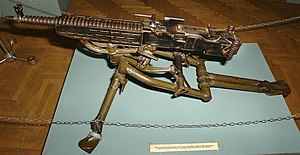ZB-53
This article needs additional citations for verification. (April 2014) |
| ZB-53, Vz.37 | |
|---|---|
 | |
| Type | Medium machine gun |
| Place of origin | Czechoslovakia |
| Service history | |
| In service | 1935-1960s (Czechoslovakia) |
| Used by | Czechoslovakia, Argentina, Chile, Nazi Germany, Iran, Republic of China, Israel, United Kingdom, Romania, SFR Yugoslavia |
| Wars | Second World War Second Sino-Japanese War Vietnam War Israeli War of Independence |
| Production history | |
| Designer | Václav Holek |
| Designed | 1930 |
| Manufacturer | Zbrojovka Brno |
| Produced | 1935-early 1950s |
| Specifications | |
| Mass | 21 kg (46 lb) empty |
| Length | 1.105 m (43.5 in) |
| Barrel length | 0.736 m (29.0 in) |
| Cartridge | 7.92×57mm Mauser |
| Calibre | 7.9 mm |
| Action | Gas-operated |
| Rate of fire | 500–800 round/min |
| Feed system | 225-round metal link belt |
The ZB-53 was a Czechoslovak machine gun. A versatile weapon, it was used both as a squad support weapon, as a mounted machine gun for tanks and other armoured vehicles, and on fixed positions inside Czechoslovak border fortifications. Adopted before the World War II by the armies of Czechoslovakia (as TK vz. 37) and Romania, it was also license-built in the United Kingdom as the Besa machine gun. Following the Munich Agreement the German Wehrmacht captured large quantities of the weapon and used it during the war under the designation of MG 37(t).
The ZB-53 was designed by Václav Holek and Miroslav Rolčík of the Zbrojovka Brno works as a replacement for the Schwarzlose machine gun of World War I origin. Based on the earlier vz. 35 machine gun, the prototype was tested in 1936 and the following year the new machine gun was adopted by the Czechoslovak Army with the designation TK vz. 37 ("Heavy Machine Gun Mark 1937").[1] It was introduced as the standard machine gun of Czechoslovak LT-35 and LT-38 tanks. Czechoslovakia exported the gun to Romania, Yugoslavia, Argentina, Afghanistan, Iran and China (roughly 850 pieces used during the Second Sino-Japanese War), while UK bought a license and started to produce its own version, known as the BESA (over 60,000 pieces made).
The weapon was a gas-operated, belt-fed, air-cooled machine gun that served both the infantry support and vehicle weapons roles. The machine gun was delivered in three variants: infantry machine gun (on heavy tripod), heavy bunker machine gun (with heavier barrel, marked "O") and for armoured vehicles (marked "ÚV"). It was designed to withstand five minutes of constant fire, after which time the barrel had to be changed due to wear. Although modern, the weapon was prone to jamming due to complicated rate of fire selection mechanism.
Czechoslovak Zbrojovka Brno and then Zbrojovka Vsetín produced the gun in large quantities until the 1950s.

See also
References
- ^ "TK" stands for "těžký kulomet", heavy machine gun, while "vz" means "vzor", Model
- Andrzej Ciepliński; Ryszard Woźniak (1994). Encyklopedia współczesnej broni palnej (in Polish). Warsaw: WiS. ISBN 83-86028-01-7.
{{cite encyclopedia}}: Missing or empty|title=(help)
